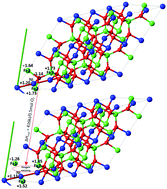Reduction enthalpy and charge distribution of substituted ferrites and doped ceria for thermochemical water and carbon dioxide splitting with DFT+U†
Abstract
The thermal reduction step of substituted ferrites (MFe2O4 where M = Fe, Ni, Co, Gd) and doped ceria (MxCe1−xO2, where M = Ce, Zr, Hf and x = 0.25) in two-step thermochemical cycles for H2O and CO2 splitting is investigated within the DFT+U framework. This thermal reduction step is described as the oxygen vacancy formation energy (reduction enthalpy), i.e. the energy required to create an oxygen vacancy in the crystal lattice. Oxides with a lower oxygen vacancy creation energy are easier to reduce. A Bader charge analysis of the reduction mechanism is carried out providing the charge distribution of the bulk and reduced ions, enabling interrelations of the substitute ions and the resulting reduction energies. Based on the approach presented here, interesting solar fuels producing materials are CoFe2O4, NiFe2O4 and Hf0.25Ce0.75O2.


 Please wait while we load your content...
Please wait while we load your content...